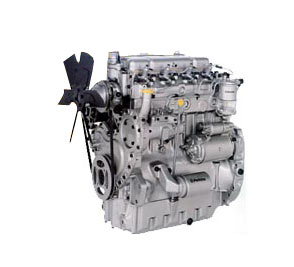

Blog
The 4.236 Engine
|
Perkins had relied on the P4 engine during the years after the war as the power unit for many applications from passenger cars to industrial equipment. By the end of the 1950s the engine was becoming outdated, with the indirect ‘Aeroflow’ combustion system becoming uncompetitive with new generations of engines from other manufacturers. In the late 1950s a decision was made to produce a four-cylinder version of the 6.354, applying the engine ‘family’ concept to the successors to the original ‘P’ series. The tractor version was basically tailored to the needs of the parent company Massey Ferguson, having a cylinder block with cast-in adaptor for the transmission housing and starter motor position plus a heavier front end to suit the frameless tractor chassis. To combat vibration problems associated with a large capacity four-cylinder engine rigidly mounted into such a chassis, the engine incorporated a Lanchester balancer in the sump. Driven at twice engine speed and featuring twin counter-rotating weights, this unit balanced out most of the second order imbalance inherent in a four-cylinder in-line engine. The engine was closed with a massive cast iron sump, which also formed part of the tractor backbone.   In 1964 the new factory was formally opened and volume production started, reaching 2,553 engines for that year and increasing rapidly to over 60,000 engines by 1969. Little has been said so far of ratings. The original target was for 80 BHP at 2800 RPM for the vehicle version and 65 BHP at 2200 RPM for the tractor version. This was just a start however. Many variants of the basic engine were to follow, as the engine became the workhorse for many customers. Thus the original swept volume of 236 cubic inches was soon followed by the 4.248 (3.975 inch bore in place of 3.875 inches) and the 4.212 (4.5 inch stroke in place of 5 inches). As a result of an agreement with Togyo Kogyo in Japan, short stroke, indirect injection versions of both the 4.236 and 6.354 engines were developed, the 4.224 and 6.335 respectively, these being exclusively for trucks in the Far East. As more licensee agreements were signed around the world, the 4.236 family of engines became the preferred product. New plants in Mexico, Peru, Turkey, Brazil, Yugoslavia, Japan, Poland and Korea all took this engine as their basic product, often to support local MF tractor production. As with the 6.354, there were numerous upgrades and product improvements over the years. However by the 1980s legislative requirements and competitive pressure demanded more radical change. The changeover to the 1000 series family was simultaneous for the 4.236 and 6.3544, although volumes remained high on the 4.236 family for longer. The last 4.236 to be built in Eastfield came off the assembly track in 2000, by which time a total of 2,190,838 engines (including all variants) had been assembled in Peterborough alone. This represents the highest production volume of any Perkins product, and probably doubles if all overseas-built units are taken into account! The 4.236 family was the backbone of Eastfield production for nearly 30 years, powering more Massey Ferguson products than any other engine type, to say nothing of the huge number of applications for other major manufacturers and for small specialist concerns Thank you to the Perkins Hertigate Club and Dave Boulton August 2002 and a more detailed version can be found on https://sites.google.com/site/perkinslongserviceclub/heritage-snippets/the-4-236-engine David Boulton August 2002. |

